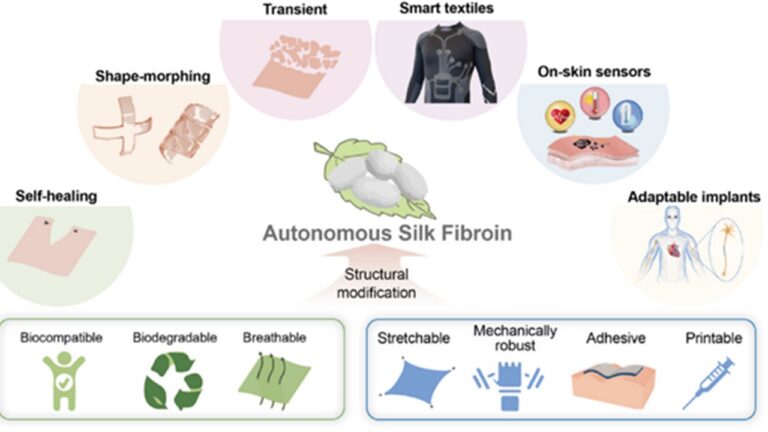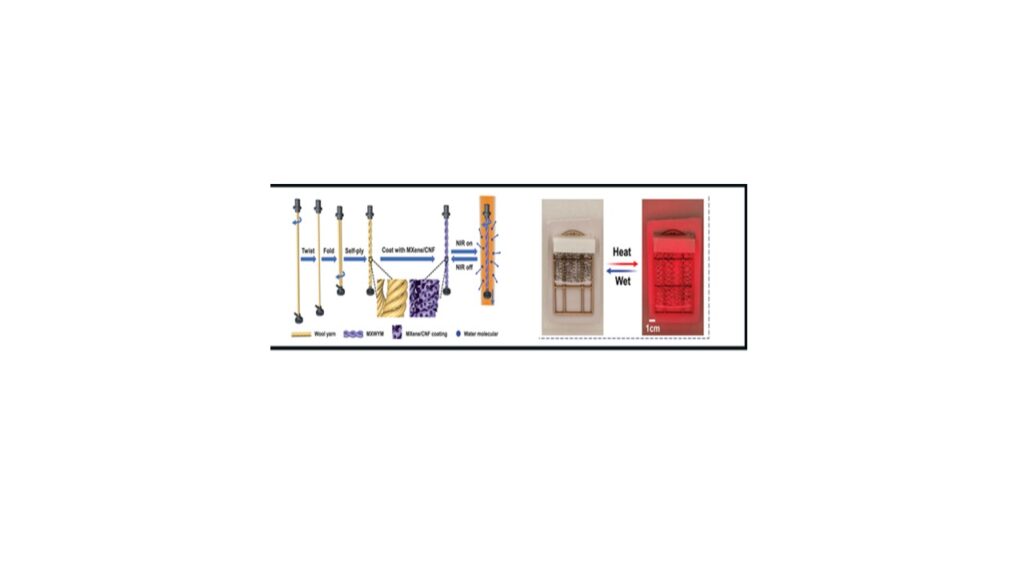Recent Advances in Materials Research: Bioelectronics, Smart Textiles & Energy Systems
August 4, 2025
Publication
- Recent Advances in Materials Research: Bioelectronics, Smart Textiles & Energy Systems
- August 4, 2025
Autonomous Bioelectronic Devices Based on Silk Fibroin

The development of autonomous bioelectronic devices capable of dynamically adapting to changing biological environments represents a significant advancement in healthcare and wearable technologies. Such systems draw inspiration from the precision, adaptability, and self-regulation of biological processes, requiring materials with intrinsic versatility and seamless bio-integration to ensure biocompatibility and functionality over time. Silk fibroin (SF) derived from Bombyx mori cocoons, has emerged as an ideal biomaterial with a unique combination of biocompatibility, mechanical flexibility, and tunable biodegradability. Adding autonomous features into SF, including self-healing, shape-morphing, and controllable degradation, enables dynamic interactions with living tissues while minimizing immune responses and mechanical mismatches. Additionally, structural tunability and environmental sustainability of SF further reinforce its potential as a platform for adaptive implants, epidermal electronics, and intelligent textiles. This review explores recent progress in understanding the structure–property relationships of SF, its modification strategies, and its great potential for integration into advanced autonomous bioelectronic systems while addressing challenges related to scalability, reproducibility, and multifunctionality. Future opportunities, such as AI-assisted material design, scalable fabrication techniques, and the incorporation of wireless and personalized technologies, are also discussed, positioning SF as a key material in bridging the gap between biological systems and artificial technologies.
Researcher/Author:
NTU – Prof Xiaodong Chen,
Yanling Wang
Tsinghua University – Xue Feng
Published in:
Advanced Materials (23 March 2025)
To download the paper, please proceed to:
DOI: https://doi.org/10.1002/adma.202500073
Dual-Responsive MXene-Functionalized Wool Yarn Artificial Muscles

Fiber-based artificial muscles are promising for smart textiles capable of sensing, interacting, and adapting to environmental stimuli. However, the application of current artificial muscle-based textiles in wearable and engineering fields has largely remained a constraint due to the limited deformation, restrictive stimulation, and uncomfortable. Here, dual-responsive yarn muscles with high contractile actuation force are fabricated by incorporating a very small fraction (<1 wt.%) of Ti3C2Tx MXene/cellulose nanofibers (CNF) composites into self-plied and twisted wool yarns. They can lift and lower a load exceeding 3400 times their own weight when stimulated by moisture and photothermal. Furthermore, the yarn muscles are coiled homochirally or heterochirally to produce spring-like muscles, which generated over 550% elongation or 83% contraction under the photothermal stimulation. The actuation mechanism, involving photothermal/moisture-mechanical energy conversion, is clarified by a combination of experiments and finite element simulations. Specifically, MXene/CNF composites serve as both photothermal and hygroscopic agents to accelerate water evaporation under near-infrared (NIR) light and moisture absorption from ambient air. Due to their low-cost facile fabrication, large scalable dimensions, and robust strength coupled with dual responsiveness, these soft actuators are attractive for intelligent textiles and devices such as self-adaptive textiles, soft robotics, and wearable information encryption.
Researcher/Author:
NUS – Prof Pooi See Lee
NTU – Dr Liuxiang Zhan, Dr Shaohua Chen, Dr Yangyang Xin, Dr Jian Lv, Dr Hongbo Fu, Dr Dace Gao, Dr Feng Jiang, Dr Xinran Zhou, Dr Ni Wang
Published in :
Advanced Materials (22 April 2024)
To download the paper, please proceed to:
DOI: https://doi.org/10.1002/advs.202402196
Photo-Switchable Supercapacitors based on Photo-Responsive Azopolymers Enabling Dual Functionality in Tunable High Capacitance and Low Self-Discharge

Fiber-based artificial muscles are promising for smart textiles capable of sensing, interacting, and adapting to environmental stimuli. However, the application of current artificial muscle-based textiles in wearable and engineering fields has largely remained a constraint due to the limited deformation, restrictive stimulation, and uncomfortable. Here, dual-responsive yarn muscles with high contractile actuation force are fabricated by incorporating a very small fraction (<1 wt.%) of Ti3C2Tx MXene/cellulose nanofibers (CNF) composites into self-plied and twisted wool yarns. They can lift and lower a load exceeding 3400 times their own weight when stimulated by moisture and photothermal. Furthermore, the yarn muscles are coiled homochirally or heterochirally to produce spring-like muscles, which generated over 550% elongation or 83% contraction under the photothermal stimulation. The actuation mechanism, involving photothermal/moisture-mechanical energy conversion, is clarified by a combination of experiments and finite element simulations. Specifically, MXene/CNF composites serve as both photothermal and hygroscopic agents to accelerate water evaporation under near-infrared (NIR) light and moisture absorption from ambient air. Due to their low-cost facile fabrication, large scalable dimensions, and robust strength coupled with dual responsiveness, these soft actuators are attractive for intelligent textiles and devices such as self-adaptive textiles, soft robotics, and wearable information encryption.
Researcher/Author:
NUS – Prof Pooi See Lee
NTU – Dr Liuxiang Zhan, Dr Shaohua Chen, Dr Yangyang Xin, Dr Jian Lv, Dr Hongbo Fu, Dr Dace Gao, Dr Feng Jiang, Dr Xinran Zhou, Dr Ni Wang,
Published in: Advanced Science (22 April 2024)
To download the paper, please proceed to:
DOI: https://doi.org/10.1002/advs.202402196
- Home
- Recent Advances in Materials Research: Bioelectronics, Smart Textiles & Energy Systems
Singapore Hybrid-Integrated Next-Generation μ-Electronics (SHINE) Centre
- Block E6, #E6-5-3, 5 Engineering Drive 1, Singapore 117608
- +65 6601 8522
- shine@nus.edu.sg

